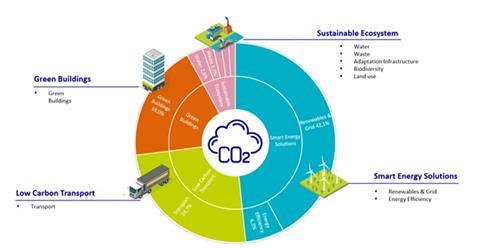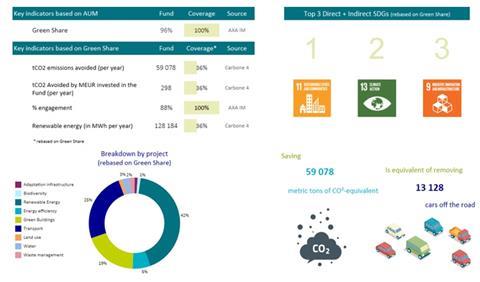| ORGANISATION DETAILS | |
|---|---|
| Name | AXA Investment Managers |
| Signatory type | Investment manager |
| Region of operation | France |
| Assets under management | €804bn |
| COVERED IN THIS CASE STUDY | |
|---|---|
| Name of fund | AXA WF Framlington Clean Economy Fund: Impact fund focusing on energy transition and resources management. AXA WF global green bonds: Impact fund invested in green bonds. |
| Sector |
Utilities, transportation, real estate, capital goods |
| Asset class | Equity, Corporate Bonds |
| Geography | Global |
| Environmental objective | Mitigation and adaptation |
| Economic activity | Mainly renewables, green building, green vehicles, smart grids |
AXA IM has established a definition of green investing for both investment and reporting purposes, using a grid organised around four green categories. The grid allows us to determine the extent to which portfolio are exposed to green activities, leveraging environmental and SDG solutions (Trucost S&P, ISS), business mix allocation databases (Factset Revere Business Industry Classification-RBICS), and established taxonomies such as the Climate Bond Initiative and French Greenfin (TEEC). We use the grid for green bonds (GBs) and green equity product selection and reporting. However, a wider application for listed and unlisted assets may be possible. We set up a quantitative and qualitative framework to identify green issuers, combining external databases and research sources, and focusing on the structure of revenues. Going forward we will review the information and data sources to refine the identification of green factors at a more granular level.
Other aspect you would like to mention?
Discussions at European level (in the context of the European Commission’s Sustainable Finance Action Plan) and the establishment of level 2 eligibility criteria for the green taxonomy will encourage the development of new tools and solutions to measure the green qualities of investments. These tools are still quite focused on core green activities, namely renewables, but investors also require other frameworks and models to capture “shades of green”, such as enabling activities and activities in transition.
Taxonomy implementation
Principles, criteria, thresholds
There was a lack of sufficient quantitative data to properly replicate the threshold requirements of the EU Taxonomy. Furthermore, criteria proposed by the EU Technical Experts Working Group (TEG) referred to different regulatory or scientifically-based frameworks. For example, current EU regulations (EU Emissions Trading System (ETS)) were often used as a reference, rather than the Paris agreement and 1.5°c pathways. This made it difficult to systematically incorporate thresholds criteria in green issuer selection. Currently, qualitative analysis coupled with quantitative metrics are required to control for thresholds and criteria fulfillment.
Do no significant harm assessment
The Do No Significant Harm (DNSH) assessment is integrated into our responsible investment strategy through ESG minimum standards. These are applied to the vast majority of our AUM, with AXA IM sectorial policies on controversial weapons, palm oil and climate risks, as well as to our RI (Responsible Investing) funds (ESG integrated funds, sustainable investing funds and impact funds representing €520bn). AXA IM ESG standards policy applies to tobacco, white phosphorus weapons, UN Global Compact (UNGC) violations and poor ESG quality.
We examined negative externalities through the application of these AXA IM RI standards to identify green issuers and the main contributors to UN SDGs.
Social safeguards assessment
As part of AXA IM RI minimum standards, we applied a systematic monitoring of most critical breaches of the UNGC principles to our overall ESG integration fund scope (ESG integrated funds, core responsible investment funds and impact funds, representing €520bn). We controlled for the most material social and environmental controversies, leveraging research conducted by Sustainalytics, which measures environment, governance (business ethics, public policy) and social impacts (employees, suppliers, customers, society & community). Each breach was flagged and, by default, excluded from investments or discussed at a dedicated committee. We then identified green qualities by ensuring that social safeguards were in place at issuer level.
Turnover/capex/opex alignment
Most green activities’ solutions/databases are based on revenues rather than Opex or Capex. We identified green qualities for investment and reporting purposes, leveraging quantitative tools and research sources. We mainly used Trucost S&P and ISS, both of which are based on a split of revenues per activity meeting specific green requirements or contributing positively to environmental SDGs. We also used more forward-looking metrics to assess “future” green revenues. Carbon Delta leverages a green patents (green innovation) database to quantify potential future exposure to green revenues.
Alignment results
The AXA IM green framework is not yet perfectly aligned with the taxonomy, because of the lack of available data and information, particularly to replicate the threshold criteria. A combination of quantitative data on revenues, Opex or Capex, and other information sources at company or activity level remains the best way to fulfil taxonomy requirements. Nevertheless, we successfully used criteria described in the EU taxonomy for engagement and benchmarking when analysing a company or a green bond.
AXA IM internal green taxonomy: a grid to measure greenness of investments across all assets – a prototype to endorse the EU Sustainable Taxonomy

Environmental Reporting Example

Challenges and solutions
| NO. | CHALLENGE | SOLUTION |
|---|---|---|
| 1 | Thresholds are very granular and based on information generally not available on a large scale for a diverse universe. | It is key that policy makers align disclosure obligations for investors and corporates so that companies are obliged to disclose the information required to implement and promote the taxonomy. |
| 2 | Criteria and thresholds for some activities correspond to references/benchmarks that may differ from other objectives targeted by an investment strategy. For example, the Paris agreement reference is not the only one employed by the EC. Current regulation, such as the EU ETS, has also been retained as a reference to fix thresholds. | We recommend better coordination and alignment of eligibility criteria and thresholds used in the taxonomy with other references, such as the Paris agreement. |
| 3 | Thresholds and criteria are based on European references and are not always applicable for ex-Europe universe/economies | Using scientifically-based pathways rather than regulation-based criteria may result in more universal cross border references. |
Recommendations
ESG and green data is still lacking in some instances, and it will take time for providers to reach the required levels. Meanwhile, there is scope for engagement with companies and issuers to achieve better disclosure and transparency. Investors should back collaborative initiatives such as the Climate Action 100+ initiative or the Net Zero Asset Owner Alliance to push companies and climate solutions providers to share more diverse information sets. Current green identification solutions are mostly focused on revenues. More work is required to enhance green identification using Opex and Capex, and company disclosure of this information needs to improve.












